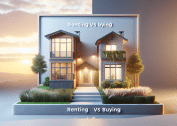Curious about what really drives home prices? Explore the often-overlooked influences on real estate values, including location trends, amenities, and market psychology. Learn what experts reveal about neighborhood dynamics, energy efficiency, and how buyers shape demand. These insights may change how you look at any property.
Neighborhood Amenities and Their Impact
Buyers often focus on the structural features of a home, but amenities in a neighborhood carry hidden weight in shaping value. Proximity to parks, community centers, or even simple walking trails adds layers of appeal for families, retirees, and young professionals alike. Real estate agents frequently note that homes near appealing amenities tend to attract more interest and maintain higher prices, driven by lifestyle demand rather than just the property itself. This trend persists whether in urban, suburban, or even semi-rural markets.
The presence of good public schools—often overlooked by those without school-age children—can significantly influence average home prices. Studies cite higher price tags for properties within sought-after school districts, as academic reputation becomes a major selling point. Even prospective buyers who don’t currently need strong educational options recognize the future value. In addition, neighborhoods with plentiful shopping, dining, and recreational options see increased foot traffic and sustained desirability, which in turn drives up property valuations (Source: https://www.nar.realtor/research-and-statistics).
Public transportation access is another amenity quietly influencing real estate values. Easy access to train lines, bus stops, and major highways isn’t just a perk for commuters; it also boosts the appeal for investors and tenants alike. As cities expand transit systems, the ripple effect on property prices becomes ever more pronounced. Some neighborhoods see major valuation shifts within a few blocks from new transit stops. Such proximity often outweighs minor home deficiencies in the eyes of buyers prioritizing time savings and convenience.
Market Psychology and Buyer Perceptions
The psychology of buying a home goes much deeper than “location, location, location.” Market sentiment can be a powerful force. News coverage, word-of-mouth buzz, or even viral listings have been known to spark bidding wars in areas previously considered quiet. Buyers often rely on the visible activity of other buyers—open houses with large crowds or multiple “For Sale” signs disappearing overnight—to gauge whether now is the right time to make an offer. This herd mentality amplifies short-term price movements in both directions (Source: https://www.brookings.edu/articles/how-housing-affects-the-economy/).
Staging and visual presentation of a property are crucial. Well-staged homes tend to fetch higher offers. The trend is supported by behavioral economics, which reveals that first impressions nudge buyer decision-making more than most admit. Clean lines, neutral decor, and even pleasing scents create emotional ties in a matter of moments. In contrast, cluttered, outdated, or poorly lit homes rarely spark the same urgency, even if the fundamentals are strong. This psychological effect is powerful enough to sway appraisals and influence negotiations.
Further influencing perception is the “scarcity principle.” When inventory levels are low, the mere sense that homes are in short supply can convince buyers to stretch their budgets. Even if the number of interested parties hasn’t changed, market chatter and visible competition boost perceived value. During such times, homes that might previously have lingered on the market find buyers much more quickly, sometimes at prices above asking as emotions outpace rational analysis.
Energy Efficiency and Sustainability
Modern buyers increasingly prioritize energy efficiency, understanding that utility costs impact monthly budgets. Homes equipped with solar panels, double-pane windows, or upgraded insulation often command premium prices. These features are no longer just “nice to have”—they’re viewed as smart investments, increasing both immediate comfort and long-term value. Some buyers even seek properties with LEED or ENERGY STAR certifications, signaling lower operating costs and eco-conscious living (Source: https://www.energy.gov/eere/buildings/articles/top-10-things-you-didnt-know-about-energy-efficient-homes).
Local building codes and incentives reinforce the shift toward green housing. Municipalities offering tax breaks for installing solar or adopting water-saving upgrades stimulate greater investment in these features. Over time, the market internalizes these upgrades, and buyers expect them as standard, especially in newer developments. This creates a cycle where energy-smart upgrades slowly shift from competitive differentiators to baseline requirements for market entry.
Sustainable landscaping is an emerging factor connected to curb appeal and environmental health. Native plantings, drought-tolerant gardens, and efficient irrigation systems reduce maintenance while increasing property desirability. Neighborhoods adopting these practices benefit from lower long-term costs, resilient beauty, and even improved stormwater management. Buyers appreciate knowing their next home can be comfortable and environmentally responsible at the same time.
Demand Shifts and Remote Work Influence
Recent years have witnessed dramatic shifts in real estate demand, particularly as remote work alters traditional commuting patterns. Once, proximity to major job centers was a must. Now, buyers are casting wider geographic nets, seeking space, affordability, and high-speed internet connectivity. Suburbs and even rural communities see new attention as telecommuting becomes normalized. Companies’ evolving work-from-home policies create demand surges in areas outside traditional hotspots (Source: https://www.urban.org/urban-wire/rethinking-housing-demand-after-pandemic).
This demand realignment means that homes with dedicated office space or flexible layouts fetch a premium. Floor plans accommodating work, school, and leisure are increasingly sought after. Features like soundproof rooms, outdoor patios, and versatile bonus spaces are now valued as highly as kitchens or master suites. Developers and remodelers have responded quickly, prioritizing these preferences in both new construction and upgrades.
Flexible demand also leads to creative housing solutions. Co-living arrangements, accessory dwelling units, and home-sharing models gain traction. In response, zoning laws and lending practices gradually adapt, reflecting this need for resilient, multi-use properties. Home values are thus influenced not just by size or luxury but by adaptability to new patterns of living, learning, and working.
The Role of Local Zoning and Regulations
Zoning codes and housing regulations quietly but powerfully shape what gets built, altered, or renovated—and directly impact home prices. Limiting certain types of development can restrict housing supply, driving prices higher where demand persists. Conversely, cities that relax rules for multi-family units, accessory dwellings, or mixed-use buildings often see broader affordability (Source: https://www.lincolninst.edu/publications/policy-focus-reports/land-lines-january-2020).
Historic districts introduce another layer of complexity. While they preserve community character, they may also limit renovations, additions, or modernizations. Buyers attracted to these areas should understand both the pride of ownership and the possible constraints. Research suggests that properties in historic districts sometimes sell at higher prices, but with restrictions that can influence long-term appreciation and flexibility.
Unpredictable permitting backlogs or policy changes, such as new minimum lot sizes or inclusionary zoning mandates, can drive short-term market fluctuations. Such factors may make certain neighborhoods rapidly more or less desirable. Savvy buyers, sellers, and investors learn to track local planning agendas as closely as mortgage rates, transforming knowledge of regulations into better decision-making power.
Long-Term Value and Investment Perspective
Successful buyers and investors often look well beyond immediate price tags, focusing on long-term appreciation and resilience. Economic cycles, gentrification, and infrastructure improvements all contribute to the trajectory of property values. Researching historical patterns of price growth within neighborhoods often reveals which areas may offer stability and growth potential, regardless of short-term trendiness (Source: https://www.fhfa.gov/DataTools/Downloads/Documents/HPI/HPI_AT_a_glance.pdf).
Shared amenities, planned community upgrades, or new public facilities can be catalysts for lasting change. Neighborhoods with active community associations frequently see increased engagement, lower crime rates, and improved public services, all of which feed into long-term, stable home values. Buyers prioritizing stability often pay close attention to these less obvious details before making a decision.
Finally, understanding market cycles and timing can help reduce risk and enhance return on investment. Knowledge of both national trends and hyperlocal data allows for more informed decision-making. By seeing past fads to the fundamental drivers of value, buyers and sellers can protect themselves from volatility while positioning themselves for steady gains.
References
1. National Association of Realtors. (n.d.). Research and Statistics. Retrieved from https://www.nar.realtor/research-and-statistics
2. Brookings Institution. (n.d.). How housing affects the economy. Retrieved from https://www.brookings.edu/articles/how-housing-affects-the-economy/
3. U.S. Department of Energy. (n.d.). Top 10 Things You Didn’t Know About Energy Efficient Homes. Retrieved from https://www.energy.gov/eere/buildings/articles/top-10-things-you-didnt-know-about-energy-efficient-homes
4. Urban Institute. (n.d.). Rethinking housing demand after pandemic. Retrieved from https://www.urban.org/urban-wire/rethinking-housing-demand-after-pandemic
5. Lincoln Institute of Land Policy. (2020). Land Lines January 2020. Retrieved from https://www.lincolninst.edu/publications/policy-focus-reports/land-lines-january-2020
6. Federal Housing Finance Agency. (n.d.). House Price Index at a Glance. Retrieved from https://www.fhfa.gov/DataTools/Downloads/Documents/HPI/HPI_AT_a_glance.pdf









